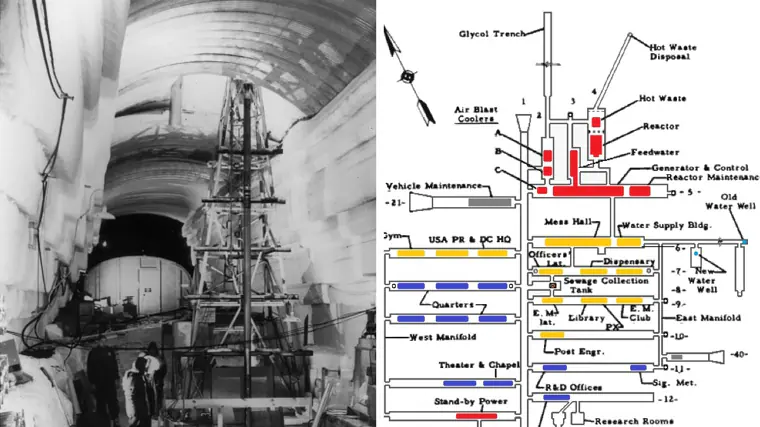A team flying over Greenland to probe the ice sheets detected, in April, something that was not natural in that vast expanse of ice. It was about a buried abandoned city under the ice, Camp Centurywhich currently remains inaccessible. Chad Greene, a researcher at NASA’s Jet Propulsion Laboratory (JPL), was the one who took the photo from the plane window. “We were looking for the ice bed and Camp Century appeared,” said Alex Gardner, also a fellow at JPL, who helped lead the project. “At first we didn’t know what it was,” he says in a statement from the agency.
Although other flights had previously been made over the area with conventional radars that produced 2D images, in April the UAVSAR was used. A synthetic aperture radar for unmanned aerial vehicles mounted in the belly of the aircraft. Basically, it produces a map with more dimensionality thanks to instrumentation that looks downwards and to the sides.
Image captured by UAVSAR
«In the new data, lThe individual structures of the secret city are visible in a way they have never been seen before“said Greene. These structures apparently line tunnels built to house a series of facilities.
What is Camp Century?
More than 1000 kilometers from the North Pole is what is known as the ‘city under the ice’. In 1951, the United States and Denmark signed the Greenland Defense Agreement. Its purpose was to negotiate agreements under which the armed forces of the parties to the North Atlantic Treaty Organization pThey hated using the Greenland facilities in defense of it and the rest of the NATO area. In short, this allowed the US to build military bases in Greenland.
The Americans told the Danish government that what they wanted was to build an air base, and in the end, they ended up establishing Thule air base and this base city. NASA explains that it was the US Army Corps of Engineers that helped build the military base in 1959. For this they excavated ora three-kilometer network of 26 steel tunnels inside the ice sheet close to the surface.
Let us remember that this is an area where temperatures They can go down to 57 degrees below zero and with winds that can reach 193 kilometers per hour. So it was quite an engineering feat that included bedrooms, a chapel, a barber shop, leisure areas and a hospital. The enclosure served harbor up to 200 soldiers and civilian personnel heated with nuclear energy. The last thing to be installed was the PM-2, the world’s first portable nuclear reactor.
Additionally, an experiment was considered on how extreme conditions would influence an isolated community, in order to understand what would happen if they settled on the Moon. However, these facilities kept a great secret. As the Nuclear Museum explains, the Army even produced a short film promoting Camp Century as a ‘remote research community.’ But it was a cover, in reality “the facility was built primarily as a test for a military operation involving nuclear missiles,” they say.
Ice worm project
It was about the war project ‘Project Iceworm’, in Spanish, Ice Worm project, which involved building a series of additional tunnels and hiding 2,100 nuclear missile silos. A railway construction would move nuclear weapons from one point to another. «The Army planned to deploy 600 missilesand build 60 Launch Control Centers. In total, the project would have required 11,000 soldiers to live full time in the city,” details Nuclear Museum.

Camp Century in 1966 and project plan
And they wanted to use a modified version of weapons that were already installed on American soil. It was about ‘Iceman’ missile, Designed as a two-stage rocket it had the ability to achieve most objectives in the Soviet Union.
The program attracted the attention of important military circles because these Iceman missiles stationed in secret locations throughout Greenland would be very difficult to attack, and this allowed for talk of the United States’ ability to carry out a second strike. Also ‘Iceworm’ was considered a way to share nuclear weapons under the auspices of NATO. However, the instability of the terrain forced this project to be discarded in 1963.
This Cold War relic would end up being abandoned in 1967. Ice accumulated in the area, and “the solid structures associated with the facility now yesThey are at least 30 meters below the surface«explains NASA.
The Thule Gate
The ‘Iceworm’ Project was kept under lock and key until 1997. Danish Institute of International Affairs (DUPI) revealed what Camp Century really entailed. Likewise, various declassified documents raised a shadow of doubt about how much the Danish government really knew about what the Americans were doing and whether they knew that nuclear weapons had been housed at the Thule base. A situation that during those years put the citizens of Greenland in real danger. The case was called the Thule-Gate. However, the story does not end here, but rather a second part begins because Large amounts of radioactive waste were buried under the snow.
His legacy
William Colgan, a researcher at the University of York, in Canada, spoke of the presence of 200,000 liters of diesel fuel and a considerable amount of polychlorinated biphenyls, which is a highly toxic compound that can cause neurological and immunological alterations in children or cancer. in animals. Likewise, there are 24,000,000 liters of wastewater and more than 47,000 gallons of nuclear waste from the plant they had.
The problem is that what was believed buried forever, with the current thaw they can change. And NASA’s rediscovery using conventional radar has corroborated Camp Century’s depth estimates, to “determine when melting and thinning of the ice sheet could re-expose the camp and any biological, chemical and radioactive waste remaining that was buried with him… For now, this new image remains a novel curiosity acquired by chance,” the agency states. While rediscovering a lost city.
#NASA #rediscovers #citysized #military #base #hidden #ice #North #Pole

